There are more than 75 species of hydrangea shrubs and thousands of hydrangea cultivars, making it among the most common and prolific garden shrubs available. Selective breeding improves classic garden varieties in many ways, especially when focused on the hydrangea’s unique feature: its spectacularly large and colorful flowerheads.
Cultivars are bred for their flower size, petal color, plant fertility levels, and branch strength, which affects the overall size and shape of the shrub. One variety of hydrangea cultivar may even be pruned into a small tree!
Incrediball® and Limelight are two cultivars with many similarities that differ only slightly in terms of flower cluster size and petal colors.
What are the other differences between the Incrediball® hydrangea and Limelight hydrangea? Read on to find out!
Comparing Incrediball® Hydrangea and Limelight Hydrangea
| Incrediball® Hydrangea | Limelight Hydrangea | |
|---|---|---|
| Plant Classification | Hydrangea arborescens ‘Abetwo’ | Hydrangea paniculata ‘Limelight’ |
| Other Names | Wild hydrangea, smooth hydrangea, seven bark, sheep flower, or ‘Strong Annabelle.’ The cultivar is officially named ‘Abetwo’ and the moniker Incrediball® is a registered trademark. | Limelight hydrangea was once known in the U.S. as ‘Pee Gee’ hydrangea. |
| Description | It is a medium-sized, broadleaf deciduous shrub bred for its spectacular showy flowerheads, which bloom on new wood in early spring. | It is a short, hardy perennial flowering shrub with large clusters of tiny flowerheads that bloom from early spring until late fall. The branches are plentiful, and spring from the base of the rapidly growing bush. |
| Origin | Hydrangea originates from Asia. The Incrediball® hydrangea is an improvement on the classic garden favorite, the ‘Annabelle’ hydrangea, with sturdier stems and larger flower balls up to 12 inches wide. | The Limelight hydrangea originates from regions of China and Japan. |
| Features | Named for the large flowerhead supported by strong stems, the Incrediball® hydrangea in full bloom is a sight to behold. Numerous flower balls that can grow to the size of basketballs produce small white flowers, which gradually change color to pale green as the season progresses. | Limelight hydrangea shrubs can reach 6-8 feet tall and 6-8 feet wide. White, yellow or green flowers, which grow on new wood, are ideal for floral arrangements and potpourri as they dry quickly when cut and retain their shape and color. |
Incrediball® Hydrangea vs. Limelight Hydrangea: Origin
The Incrediball® hydrangea is an improvement on the classic garden favorite, the ‘Annabelle’ hydrangea, bred for sturdier stems and larger flower balls that can reach up to 12 inches wide.
Limelight hydrangea is a cultivar with no native origin, bred for impressive and colorful flowerheads. It was created by Dutch horticulturist and florist Pieter Zwijnenburg in the 1980s.
Incrediball® Hydrangea vs. Limelight Hydrangea: Description
Incrediball® hydrangea is a medium-sized deciduous shrub. Its dark green leaves are large and thick. The hardy perennial can grow up to 6 feet tall and 6 feet wide. Bred for its plentiful flowerheads, the Incrediball® lives up to its name, producing many impressive flower clusters shaped like large balls and up to 12 inches wide.
Limelight hydrangea shrubs are similar in size to Incrediball®. Light green deciduous leaves are shed in the fall. In early spring, buds appear on new wood and bloom into flowerheads of the classic hydrangea shape known as paniculate. Two types of flowers grow side by side in the cluster: one sterile, showy petalled, and one small, beaded, and fertile. The Limelight is an all-around colorful garden shrub; aside from its petals, the stems range from grey and pink to silver, while the leaves are patchy yellow and green.
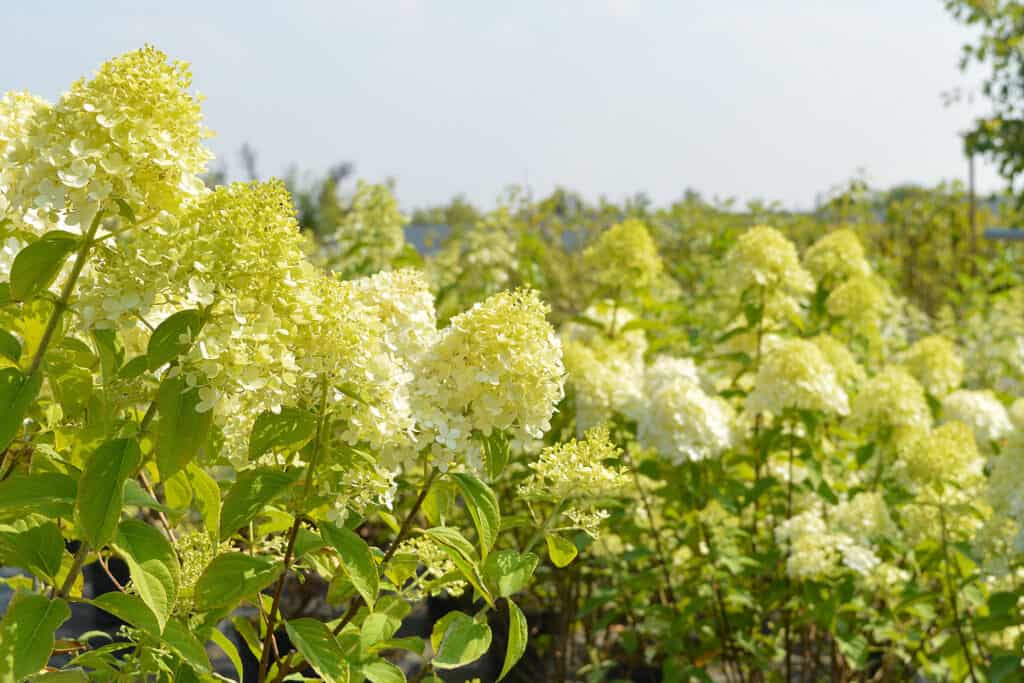
Limelight hydrangea is a cultivar with no native origin, bred for impressive and colorful flowerheads.
©Mari_Piman/Shutterstock.com
Incrediball® Hydrangea vs. Limelight Hydrangea: How to Grow
Incrediball® hydrangea thrives in full to partial sunlight. Known for their hardiness, these shrubs can withstand drought-like conditions, long periods of heat and are somewhat frost resistant. Prepare a large hole in well-drained, loamy soil in a sheltered area. Water the shrub weekly as it settles in, mulching around the base to retain moisture. These low-maintenance plants will create spectacular blooms in their first spring, which flower late into autumn. When planted side by side, Incrediball® hydrangea shrubs make an eye-catching floral hedge, sure to attract butterflies, bees, and many other pollinators to the garden.
Limelight hydrangea bushes thrive in similar situations: full or partial sunlight, sandy or loamy, well-drained soil in a sheltered position. Limelight hydrangea should be planted or transplanted in early spring into a large hole twice the size of the root ball. Water regularly at the base and ensure the plant does not get waterlogged; evidence of excess water will appear as yellowing leaves, drooping stems, and unimpressive clusters with dull petals that fall away quickly from the shrub.
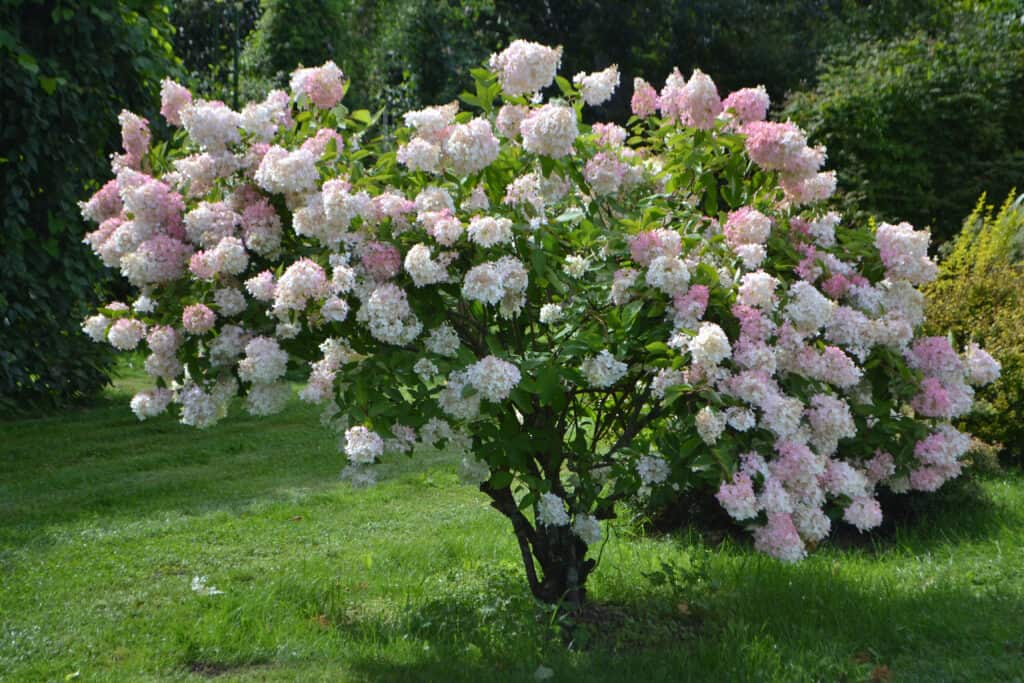
Limelight hydrangea is the only hydrangea capable of growing into a tree.
©Edita Medeina/Shutterstock.com
Incrediball® Hydrangea vs. Limelight Hydrangea: Special Features
The flower heads on Incrediball® hydrangeas are two to three times the size of other smooth hydrangea varieties. With delicate white flowers and smooth green foliage, the bush is a colorful addition to an urban garden. The stronger stems enable the flowerheads to remain upright and not droop, especially lower blooms, which struggle to thrive on the soil. Clusters undergo a dramatic color change, adding visual interest, and clusters are perfect for drying. They pick cleanly from the stem, dehydrate well, and retain their shape and color, making them ideal for indoor decoration and floral crafts.
Limelight hydrangea is the only hydrangea capable of growing into a tree! With regular pruning of the lowest branches starting early in life, the shrub can be trained into a single stem or trunk. As it takes the form of a small tree, strong weight-bearing limbs keep the showy, colorful flower clusters upright. As hydrangea trees are unique, the Limelight certainly steals the show in any garden!
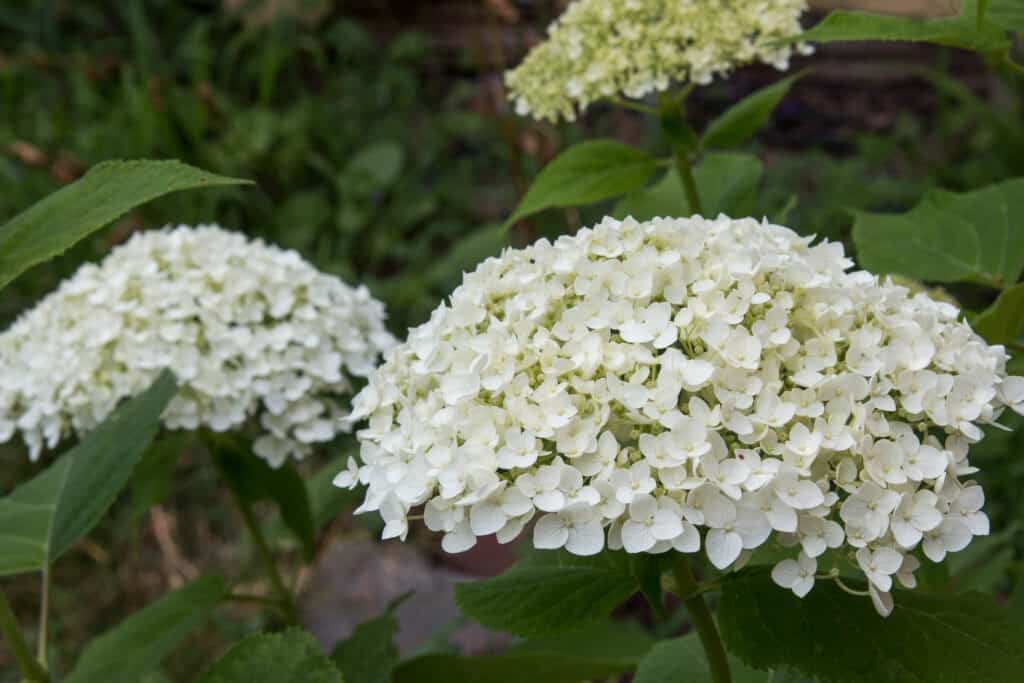
Incrediball® hydrangea flower heads are two to three times the size of other smooth hydrangea varieties.
©iStock.com/Marketa Bement
Incrediball® Hydrangea vs. Limelight Hydrangea: Flowers
Incrediball® hydrangea flowers are most impressive. Appearing white in spring, the petals cluster to form the shape of the ball it was named for. Held up on one strong stem, the extra-large balls are up to three times the size of ordinary hydrangea flowers. Color changes from white to pale green and on to a deep jade hue. The flower balls may withstand the first frost, making them a great way to add color to the garden season-long.
Limelight hydrangea flowers are bred for their dramatic blooms, which flower from early spring until late autumn in large, showy clusters. Limelight flowers bloom a light green, gradually fading to pale creamy white.
Incrediball® Hydrangea vs. Limelight Hydrangea: How to Prune
Due to their hardy, fast-growing nature, both Incrediball® and Limelight hydrangea can withstand being pruned back by about a third of the shrub’s overall height and width. Prune in early spring just as new growth begins to appear. This will encourage strong growth of new branches, providing support for large and heavy flower clusters to hang. Fertilize with a hydrangea-specific nutrient mix in springtime, any time after the last frost. Hydrangea in general is known as low maintenance garden plants with high visual rewards when the flowers are at full bloom.
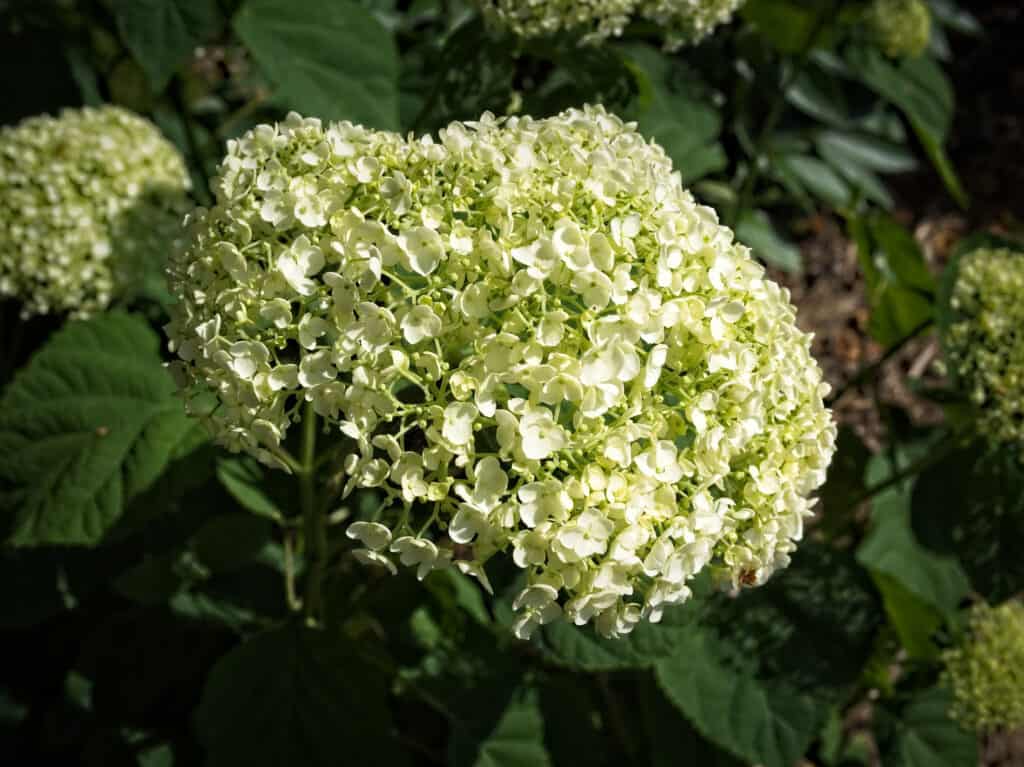
Incrediball® hydrangea flowers change color from white to pale green and on to a deep jade hue.
©F. D. Richards / Flickr – License
Incrediball® Hydrangea vs. Limelight Hydrangea: Overview
As you can see, the Incrediball® hydrangea and Limelight hydrangea have many similarities. Being cultivars from the same genus, they share the same growing cycle, prefer the same environment, and thrive under similar meteorological circumstances. They both produce massive showy clusters of beautiful flowers that change color throughout the season. Like most hydrangea varieties, they increase rapidly in height and width, yielding copious new branches from the base of the shrub.
The Incrediball® is a trademarked name for the ‘Abetwo’, bred for its spectacularly oversized clusters. The Limelight is among the only hydrangeas capable of being trained to resemble a tree. But that is where the differences between Incrediball® hydrangea and Limelight hydrangea end!
Bonus: Hydrangeas Not Blooming? We Have the Answers
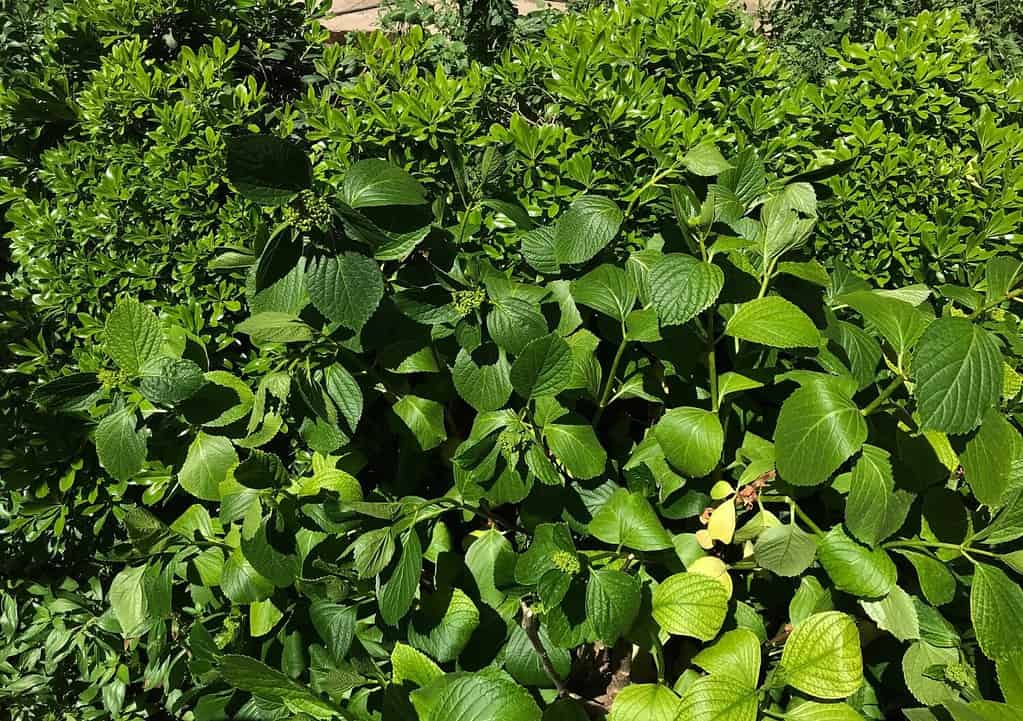
Hydrangeas that fail to bloom are a sad sight.
©Hatice Sever/Shutterstock.com
If you look forward to seeing your hydrangeas bloom every year – it is a great disappointment when those big showy blooms never come. The leaves are lush and green but either buds never form or don’t develop – what has gone wrong? There are many things that can keep your hydrangeas from blooming – here are some reasons and solutions:
- Too Much Shade. Depending on the variety – most hydrangeas can tolerate a little shade – but most need several hours of direct morning sun. Consider moving your plant to a better location.
- Too Much Sun. Apparently, a sweet spot must be found for these plants. Too much direct sun may stress the plants causing them to conserve energy by not flowering.
- Improper Pruning. It is crucial for you to learn whether your hydrangea variety blooms from old wood or new – and prune accordingly. Bigleaf, oakleaf, climbing, and mountain varieties all bloom on old wood. Unless they get too big – it’s best not to prune them at all. The blooms will dry out and be replaced with new flowers next season. Panacle and smooth varieties bloom on the current season’s growth. (Limelight and White Wedding) Prune these in late winter or early spring.
- Cold Weather. A harsh winter or hard freeze can damage developing flower buds, which may result in a summer with no flowers. Mulch the area around the base of the plants in fall with several inches of leaves or straw to insulate roots. Protect plants with a covering during cold spells or frosts.
- Not enough water. Hydrangeas need a lot of water to do well. Too little water can result in stunted growth or no blossoms the next season. If plants are drooping or wilting they need to be watered immediately.
- They are too young to bloom. It can take newly planted hydrangeas up to 5 years before they begin blooming. You can buy larger plants if you want flowers sooner.
The photo featured at the top of this post is © Michele Dorsey Walfred / Flickr – License / Original
Sources
- Hydrangea Guide, Available here: https://www.hydrangeaguide.com/limelight-hydrangea/
- Home for the Harvest, Available here: https://www.homefortheharvest.com/incrediball-hydrangea/
- Hydrangea.com, Available here: https://www.homefortheharvest.com/incrediball-hydrangea/
- the Spruce, Available here: https://www.thespruce.com/description-of-incrediball-hydrangeas-2132707
Thank you for reading! Have some feedback for us? Contact the AZ Animals editorial team.






